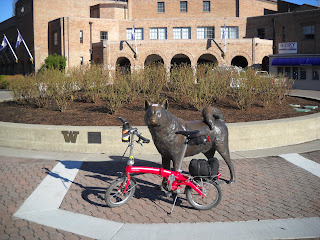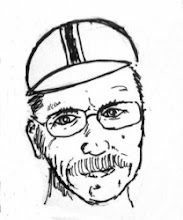
Years ago I went to see Tim O'Brien
He goes on to tell about a fellow named Tim O'Brien growing up in a northern state, who has plans and dreams and one day he gets a draft notice telling him to report for duty. He tells of a trip to a wilderness lake, one that borders Canada and of that young man there with a canoe and the draft notice in his pocket and thoughts in his head about the choices we make and the lives that we live. Leaving that canoe on one side of the lake or the other would make difference on that day and all the days that follow...
"Wow," Tim says, glancing at his watch, "it's getting pretty late. Are there any other questions?" The reading room at Elliott Bay Books erupts in a chaotic chorus all asking the same question "What did you decide on the shore of that lake? Did you go to Canada or Viet Nam?"
Tim smiles broadly at this room full of people who buy his stories, "I have a job where I make up stories and people buy them..."
I have a job where I sell and repair bicycles. Unlike Mr. O'Brien, I don't only sell a story. At the end of the day the thing that I say will roll and shift and stop on command has to actually roll and shift and stop on command or I will lose customers, credibility and sales. I stay in the bike business by doing my very best to make sure the stories I tell about the bicycles are true.
It is also very true that the most important thing I sell is a story where the customer is happy on their bicycle. What makes my job easy and fun is that I honestly believe that bicycles are easy and fun and good. To make sure that the customer comes to that same conclusion, I work from one basic principle: the most important character in the story is not the bicycle and it certainly isn't me. The most important character in the story is the customer. And that character isn't just a character, that person is the real person who will make this story real.
The two most important things I do with a customer are ask questions and listen to answers. I know a bit about bikes, but I know very little about the person who just walked into my shop. Asking the right questions is something of an art. For example "What kind of bike are you looking for?" isn't nearly as good a question as "what kind of riding do you see yourself doing?" The former question elicits a one or two word response, while the second question reveals much more.
Any dialog is more than questions and answers and anyone who knows me will tell you that I am a guy who tells a lot of stories. I think we all do this, stories are how we make sense of our lives. Stories are one important way that we relate to each other. Together the questions and the answers and the people in the conversation tell a story and our lives are shaped and changed by the stories we tell and live.
A while back a pretty big guy came into the shop and we got to talking. "I don't suppose you have any bikes for a guy my size..." he said. "Me personally? Nope," I said, "I'm a scrawny little guy. But they're making some pretty beefy bikes these days, not just feather-weight race machines. Let me tell you about my friend Scott..." And I proceeded to tell him about my friend Scott, who weighed 500 pounds when he decided to start biking and who had to stop and rest multiple times just to get around the block. But Scott kept riding and these days he weighs about 170 pounds.
And now the story goes a little further because now this guy who is smaller than Scott was and bigger than Scott is has gotten himself a bicycle and is out there riding. Because stories can and do make a difference.
In my days working for the Bicycle Alliance of Washington I learned not to waste my time trying to convince people who don't want to ride in the rain and dark that it can be fun to ride in the rain and dark. Instead when somebody would say "I'd like to bike commute but I don't want to ride in the dark," I'd say "Don't do it!" But then I'd point out that the days are long in the summer so maybe they just want to try bike commuting on summer days. If they wanted to avoid the rain, I'd suggest watching the forecast skipping the rides on the damp days. If their commute was too far to bike, maybe they'd want to try using the bus for part of the trip. The key thing was listening to the objection and not dismissing it. Some times these people never became bike commuters, some became part-time bike commuters but a surprising number after taking that first step find they enjoyed biking to work. And then they realized they might not need to stop riding to work just because of some rain or some darkness. They'd come back, sometimes months later and ask about lights or rain gear. When you start a story, sometimes it goes on longer than you think it will.
Let me tell you another story. Years ago, when I worked at Sammamish Valley Cycle, a fellow comes in and answers my "what kind of riding do you see yourself doing?" question by saying that he's going to be riding across the United States and he's looking for a bike. He's a small guy (and by that I mean he's a bit shorter than me). We don't have a touring bike in stock that will fit him and while I do tell him about the Marinonis we can order, I also tell him about the Adventure Cycling Association, Rivendell, things he should look for in a bike and various used bike possibilities included older non-suspended mountain bikes or older touring frames. I mention Bike Works and I can't now recall if he nodded and said he knew about them or if I was giving him new info, but I also told him that at his size I thought a 26" wheeled Rivendell Atlantis would be a great bike to look at and the Bob Freeman had them in stock in Seattle at Elliott Bay Bicycles. We wind up talking for well over an hour and eventually this guy, whose name is Bill, goes on his way.
Later, I get a call at the shop. It's Bill. He's at Elliott Bay and he's test ridden the Atlantis. He likes it. "Do you think I should buy it?" he asks.
"If you like it and it fits you and you can afford it, sure. It's a good bike," I reply.
"But I feel guilty, you spent so much time with me..." Bill explains.
"Look," I say, "Bob's got a good bike there. Buy it and don't worry. If you want you can come back here and I'll be happy to sell you a whole bunch of touring bags and other stuff for your trip."
And that's how I met Bill Lippe. Bill did buy the bike from Bob at Elliott Bay and some bags from me and took his trip across the U.S. He also got quite involved in bicycling in the Seattle area and over the years various people came into Sammamish Valley Cycle, bought bikes and said "Bill Lippe sent me." Quite a few years later I wound up sending my resume and application for an interesting job at Bike Works, the funky little non-profit in the Columbia City neighborhood of Seattle. I'd done some volunteer work at Bike Works before and I knew a lot of the staff through some joint projects they'd done with the Bicycle Alliance of Washington. I'm pretty sure I wound up getting the job through my merits, but I also know that I probably got the interview because I had a strong recommendation from the Bike Works Board President, a fellow named Bill Lippe.
When you start a story, sometimes it goes on longer than you think it will.
I have a job where I tell stories about people and bicycles. People buy the bicycles, ride them and are happy. How could I not take a job like that?
Keep 'em rolling,
Kent "Mountain Turtle" Peterson
Issaquah WA USA

















































